If you ask someone where a complete beginner can practice their stock investing skills, most people will refer you to Investopedia Simulator. After all, it’s one of the most famous platforms of the fantasy trading genre. Therefore, it’s only expected for there to be several plus points for it.
With that being said, Investopedia Simulator is extremely old at this point and hasn’t seen a proper update in many years. Because of this fact, chances are that newcomers to the investing world might want an in depth analysis of Investopedia Simulator, which is exactly what we’re here to give you.
Of course, we aren’t like other reviewers. Where most reviews on the internet tend to give you surface level information to make the platform sound as good or as bad as possible, you can expect unbiased pros and cons from us.
If an old trading simulator isn’t what you’re looking for and you would much rather learn from a modern one, we have you covered from that angle too. We highly recommend you give the new Three Investeers trading simulator app a shot and get started with $100,000 worth of virtual money.
What is Investopedia Simulator

As we mentioned above, Investopedia Simulator is one of the most popular fantasy trading simulators out there. It’s an online platform that was built with the intent of allowing newcomers to the trading world a virtual trading environment to practice investing without risking real money.
The simulator itself was created by Investopedia, a leading online resource for financial education and information. Having first graced the internet way back in 1999, we can confidently say that Investopedia Simulator has been around for longer than most investors have.
One might even call this an online game that gives you the opportunity to experience the dynamics of financial markets, execute trades, manage portfolios, and track performance, all using virtual currency.
Benefits of Investopedia Simulator
Now that you have a basic idea of what Investopedia Simulator is, we’ll be going through some of this platform’s plus points first,
User Friendly Interface
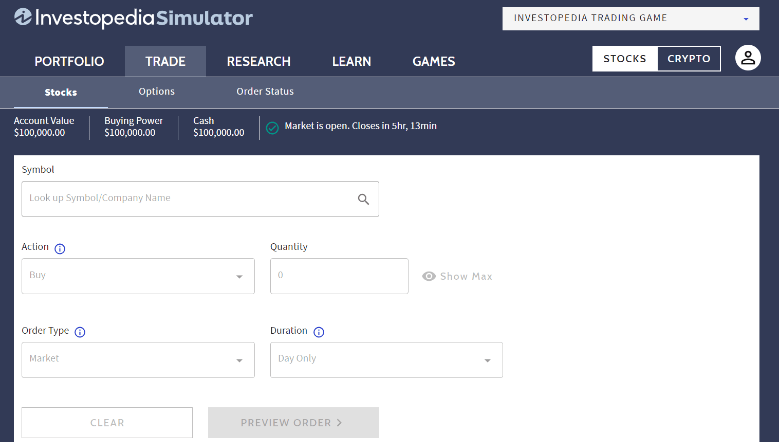
The first and perhaps most attractive feature of Investopedia Simulator which is sure to bring in newcomers is how user friendly the platform’s interface is. Simplicity seemed to be key when designing the platform and it really shows.
Users are able to easily navigate through the various sections and features of Investopedia Simulator whereas many similar platforms are needlessly complicated. From creating and managing portfolios to executing trades and monitoring performance, the intuitive layout makes the entire process seamless and accessible.
This easy to navigate layout also makes the process of using this platform easy for newcomers and veterans alike. It enables individuals with little to no prior experience to quickly grasp the essentials of investing and get started with confidence.
Realistic Trading Experience
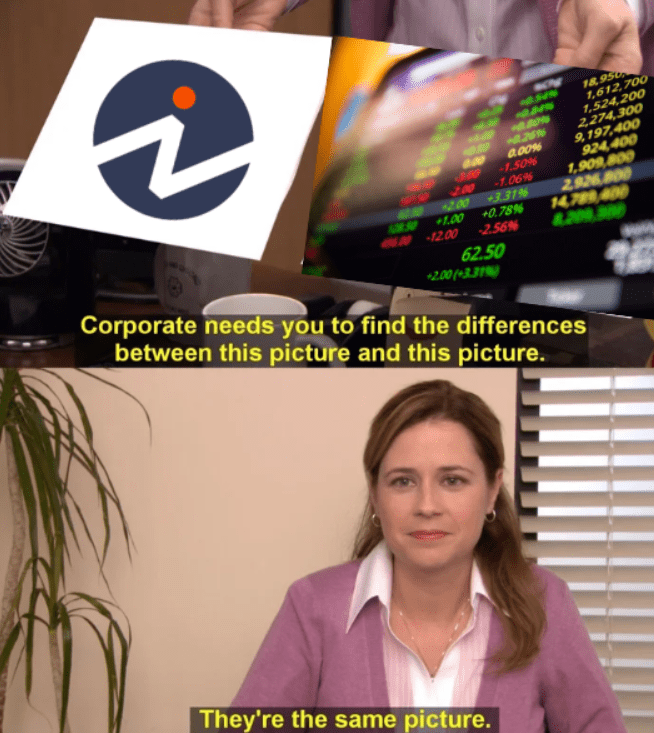
Although providing a realistic experience is literally the one job fantasy stock trading simulators have, we thought it still deserved to be appreciated in this review. By incorporating market data, the simulator enables users to experience the dynamic nature of financial markets. Notice how we didn’t say ‘real time’ market data? Well, a little more on that later.
Users are able to monitor the prices of stocks and react to market news to execute trades that have the potential to be profitable. Naturally, these trades aren’t always profitable, and learning to avoid losses like you would in an actual market is a crucial skill Investopedia Simulator teaches newcomers.
By trading in a volatile market, even if it’s with virtual money, users are able to familiarize themselves with the ins and outs of trading. This prepares them for actual trading with actual money.
Vast Collection of Learning Material
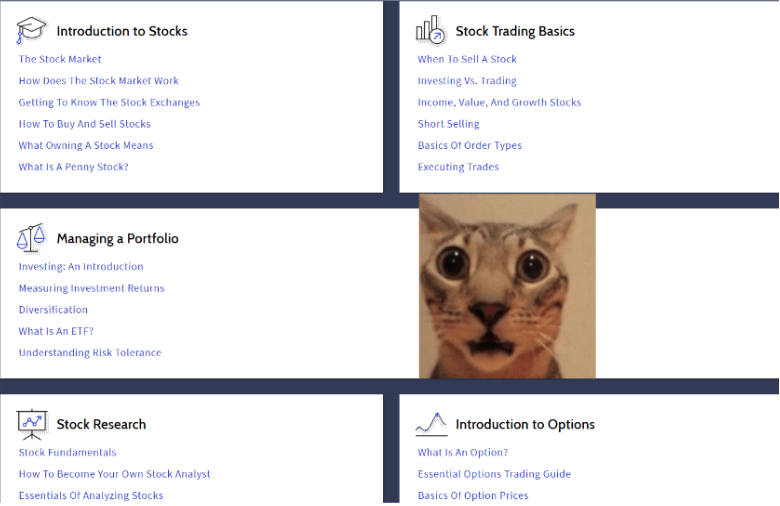
In addition to giving users a way to trade with virtual money, Investopedia also provides various articles, tutorials, videos, and quizzes that cover a wide range of investment topics. This learning material not only covers the basic concepts of trading but also gradually tackles some more advanced strategies like options trading.
In addition to these primary learning materials, the Investopedia Simulator also offers supplementary resources such as glossaries, case studies, and real world examples that users can learn from. These resources provide additional context and practical insights, allowing users to connect theoretical knowledge with real life scenarios.
By exploring these supplementary materials, users can deepen their understanding of investment concepts and gain valuable insights into how these concepts apply to actual market situations. By catering to traders of different skill levels, Investopedia Simulator is also able to provide valuable insights and guidance to users as they progress in their investment journey.
Community Building and Competition

Investopedia Simulator also fosters a sense of community and healthy competition among users. By offering various challenges and friendly competitions where players can compete against each other, there’s an added sense of motivation and excitement. Of course, there are also opportunities for users to learn because of all of these challenges.
By going to the ‘games’ section of the platform, you’ll instantly be greeted by a leaderboard that will display accounts with insanely high account values. From there, you’ll have the option to either join a game or create your own game. Different games have different requirements, limitations, and starting cash that you can use to get an overall profit.
Additionally, the simulator features discussion forums and interactive elements that enable users to connect with like minded individuals, ask questions, and seek advice from more experienced investors.
Drawbacks of Investopedia Simulator
With all of the unique advantages of Investopedia Simulator tackled, we will now be highlighting every drawback we noticed from our time using this platform.
Outdated Trading Platform
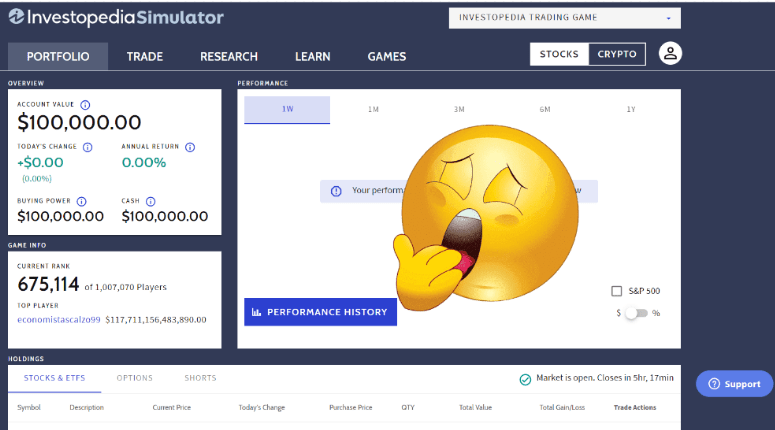
While the interface is indeed very user friendly, it’s mostly because the website itself is, well, very empty. There are various features you can find in modern trading simulators like Three Investeers trading simulator that are completely missing in Investopedia Simulator.
Now, this outdated website has two consequences. The first is that the platform is limited in terms of what users can do with it. There are several options that newcomers to trading might struggle to even find, let alone learn how to use. Because the website is old fashioned, it’s crucial to click on each and every window and option if you want to understand what it does, something that not everyone might want to do.
The second direct result of an outdated user interface is the fact that some users might not find Investopedia Simulator’s design visually appealing. Instead of the visually appealing images and logos you might see in modern trading simulators, Investopedia simply has a plain and boring blue color scheme
One might argue that the developers choose to prioritize polishing existing features over launching new ones, but all that does is increase the possibility of modern features being missing. These features can range from things that might make the trading process for users easier or simpler to basic social features that can enhance learning.
Static Charts
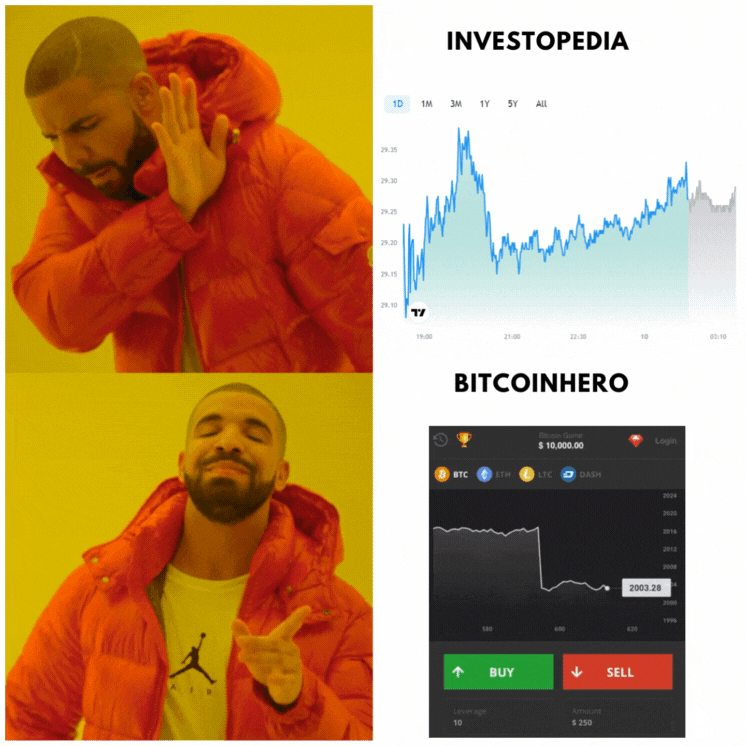
In today’s world, where the price of assets is always changing by the minute, it’s crucial to stay up to date. However, while various investing simulators offer live charts that display the changes in real time, Investopedia Simulator shows a static chart that refreshes once every few minutes.
In real life fast paced markets, every second counts, and delays in accessing information can result in missed opportunities or undesirable outcomes. Real time charts provide traders with instantaneous updates, allowing them to react swiftly to changing market conditions. This responsiveness helps traders to stay ahead of the market and take advantage of short term price movements or emerging trading opportunities.
Additionally, real time charts also provide users with a much more immersive and engaging experience. Real time visual feedback has the potential to enhance traders’ understanding of market dynamics and enable them to develop a better sense of timing and market behavior. They continuously update with the latest market data, reflecting the most current price movements, volume, and other key metrics. This real-time data allows traders to stay informed about market conditions, spot trends as they unfold, and make more accurate predictions.
Offering a real time trade environment to users is what many veteran traders consider to be the bare minimum, and Investopedia Simulator doesn’t do it.
Limited Country’s Stocks Available

The global stock market is a vast and diverse one, with people all around the world joining it every day. Despite that, Investopedia Simulator, one of the oldest trading simulators out there, only offers the option to trade the stocks of certain countries instead of allowing users to delve into other markets as well.
While this does help in gaining an in depth understanding of the stock market of the selected countries, it also isolates many users who might not have the luxury to easily trade in foreign stocks.
To be more specific, several European juggernaut companies are non existent in Investopedia. For example, influential companies such as Volkswagen in Germany and LVMH in France (the creators of famous brands like Dior and Louis Vuitton) are two companies that we’re sure many users would want to invest in. However, because they aren’t available in this trading simulator, there’s no way for them to familiarize themselves with them.
Limited Asset Choice

Investopedia Simulator is a stock trading simulator, yes, but it never hurts to have more than just the bare minimum, right? Well, this platform does indeed allow users to easily trade not only stocks but also options, and more recently crypto. However, there are still various assets that are neglected.
As an example, let us look at a modern trading app like Three Investeers. In addition to the expected stocks, users of Tree Investeers are also able to trade other assets such as forex, index funds, crypto, and commodities like gold and oil.
No Watchlist Functionality

A watchlist is a list of securities that you monitor in the hopes of a potential trade or investment. However, Investopedia Simulator offers no watchlist feature to users. By creating a personalized watchlist, traders tend to quickly access and review the real time data and price movements of their selected asset, so you can imagine how this platform not having this feature can be a major drawback.
Moreover, a watchlist provides traders with a holistic view of their chosen assets, enabling them to identify trends, patterns, and potential trading opportunities more effectively. Without a watchlist, it’s very likely that traders, even some experienced ones, might struggle to maintain a systematic approach to tracking assets and may miss out on key insights that could impact their trading strategies.
Bland User Experience

The website of Investopedia Simulator, while fully operational, is rather uninspired and bland. It seems as though the platform suffers from a lack of user engagement which results in the entire experience feeling rather static and boring. A dynamic and interactive interface is what brings life to any platform or website, and that’s completely missing.
Of course, there is a leaderboard system in place as well, but even that’s unimaginative and rigid. For example, take the fact that although it’s possible to join multiple games at once if you want to switch the displayed leaderboard, you’ll have to go back to the games section, select the other game, and then back out. Instead, wouldn’t it have been more convenient had they just given users the option to switch the leaderboard from, you know, the leaderboard page?
Poor Mobile Experience
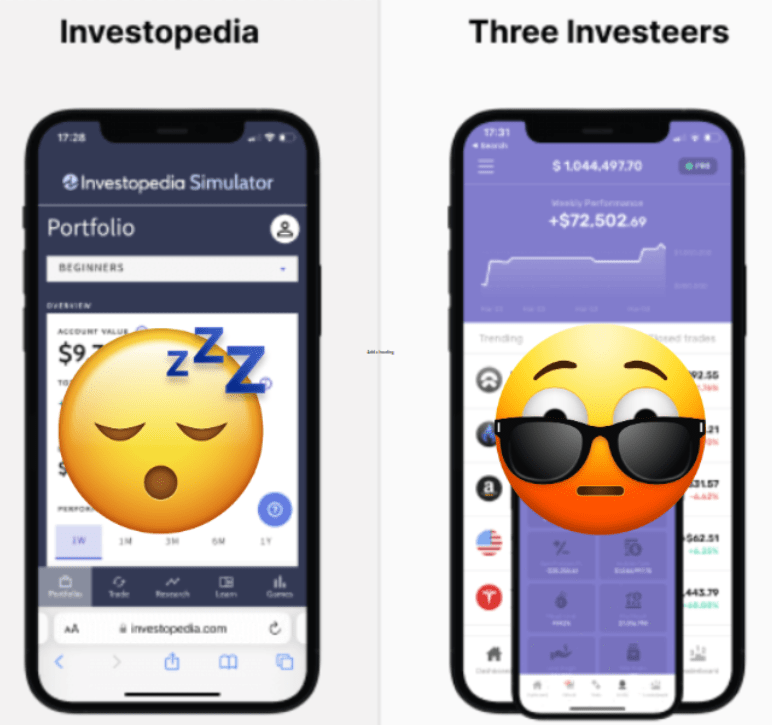
Perhaps the biggest drawback of Investopedia, especially in this day and age, is the fact that the mobile experience of the platform is rather poor. Low spec mobile phones lag a lot, and there have been many reports of some default mobile browsers outright crashing when using this app Because the platform itself is rather outdated and in need of some major revamping, users might find themselves having to struggle a lot when trying to use it on a mobile device.
As you can imagine, many stock traders use their mobile devices to conduct quick trades when not in the comfort of their homes. Because the stock market is extremely volatile and ever changing, and the fact that you can’t be sitting in front of your computer’s screen the whole day, a good mobile experience is very important for certain users.
Does Investopedia Simulator Use Real Money?

No, Investopedia Simulator does not use any real money. Similar to the other stock simulator platforms of its kind, users are given a set amount of virtual money. They then have to use that money to invest in stocks that are in a realistic and dynamic market. With smart decisions and proper market research, users are able to make a high amount of virtual profit, even if they don’t really get that money in real life.
The main goal of Investopedia Simulator is to provide newcomers to the stock trading world a risk free way of learning how investments work. While the money spent is indeed virtual, the market invested in is a completely identical simulation to the real deal. This means if you make a profit on an investment in this, then you would have been a profit had you made the investment with actual money too.
To be more specific, when signing up for Investopedia Simulator, users are given an amount of $100,000 to use on whatever stocks they want. While smart newcomers will first learn how to read the market and make smart investments, there are also many users who simply plunge head first into whatever investment sounds good at the time. In this scenario, the second type of user often ends up running out of their starting money, which you might call game over.
Those who were able to earn are able to then go up against other similar users to see who’s able to make the most profit. This nurtures a friendly yet competitive environment that promotes the learning of the stock market
Is Investopedia Simulator Free?

Yes, Investopedia Simulator is completely free. After all, the idea is to give users a space where they can learn the ins and outs of stock trading without actually having to risk any of their money. Therefore, having to pay for the simulator would defeat the purpose. With that being said, some simulators do give the option of paying to remove ads. This option that isn’t available here.
Is Investopedia Simulator Legit?

Yes, Investopedia is a completely legit and widely recognized trading simulation platform that has been going on for years now. The platform offers real time market data and various educational resources to enhance the understanding of investment strategies and financial markets for users.
Investopedia Simulator is trusted by individuals, students, and professionals looking to gain practical experience in trading without the risk of real money. It is a reliable tool for honing investment skills, testing strategies, and gaining confidence in financial decision-making.
Can You Earn Real Money in Investopedia?

While some stock games like Three Investeers allow you to potentially win real money prizes, the same doesn’t apply to Investopedia. There’s absolutely no way to earn real money from this app. No limited time events and no real money rewards for hitting the top of the leaderboards.
How Does Investopedia Compare to Other Top Stock Simulators

Unfortunately, Investopedia is not the best stock market simulator out there. Despite being the second historically most popular simulator of all time, we’ve identified one simulator which has Investopedia beat on all accounts.
Of course, that isn’t to say Investopedia isn’t better than some other simulators. As you can see from our Wall Street Survivor Game review, Investopedia is an overall better simulator than a lot of other fantasy stock games.
With that being said when put up against a top modern stock trading simulator, namely Three Investeers, Investopedia came up short. You can learn more about how the top stock market apps compare against each other in our Best Stock Market Simulator Apps article.
Conclusion
With everything being said and done, is Investopedia a recommended stock market simulator app? Well, despite it being what one might call a veteran in the stock market simulation space, Investopedia fails to deliver a comprehensive and modern stock trading simulation experience.
While the app interface is straight forward and easy to navigate, the platform consistently falls short of delivering a complete market experience, especially when compared to modern platforms of the same genre. The charts are static, there’s no watchlist functionality, and the stock prices aren’t updated in real time but every 15 minutes, which might lead to users missing out on making crucial decisions.
Furthermore, the overall experience of using the platform is rather bland and uninteresting, which has the potential to turn off a lot of newcomers to stock trading. All of this, in addition to the fact that the platform does not support forex trading, are some major drawbacks of Investopedia.
Of course, there are some plus points of this platform too, otherwise, it wouldn’t have survived for all of these years. Among those plus points are this platform’s low low price of, well, free, and how Investopedia offers users a completely risk free and realistic stock market experience. However, these aren’t really characteristics to write home about, as they’re the bare minimum that are to be expected from any stock market app of this genre.
In conclusion, it might be a better idea to give more modern stock trading apps like Three Investeers trading simulator app a shot. Not only does Three Investeers have a much more up to date and interactive experience (no, seriously. Their interactive school with quizzes and Pattern Sniper is some next level stuff), but they also offer much more engaging friendly competitions with occasional real money prizes to win for performing well.
Ultimately, the choice of which trading simulator app you go for depends on individual needs and preferences. It’s important to take into consideration various factors of the platform such as how good the interface is, whether there’s the possibility of winning anything, and how entertaining the overall experience is. Remember, that at the end of the day, the most important thing is to have a platform that will aid you throughout your stock market learning journey, so choose your partner well.





